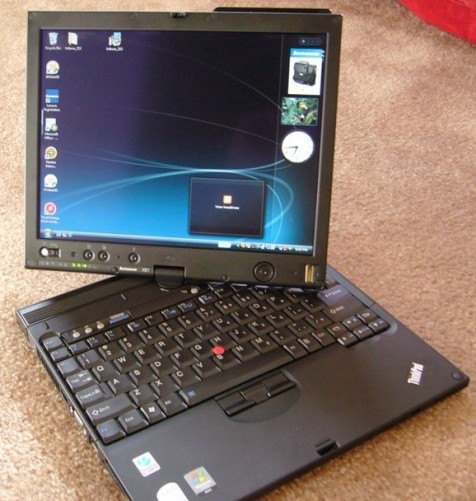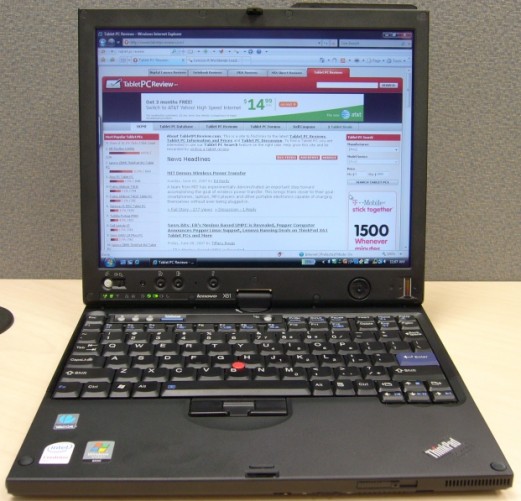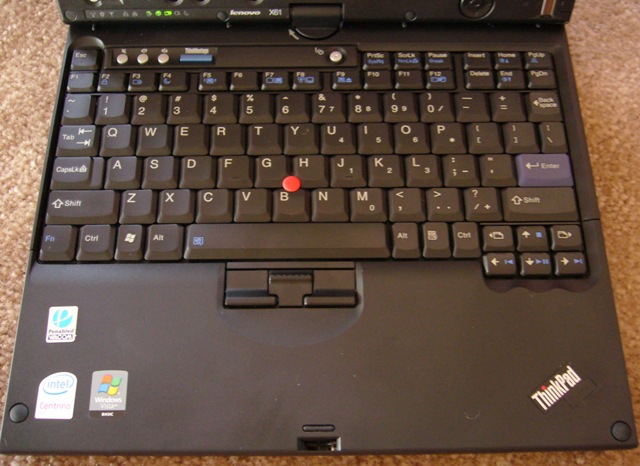Lenovo ThinkPad X61 Tablet PC Review
Lenovo’s ThinkPad X61 has been the talk of the Tablet community since its release and after spending a few days with it, I can see why. The matte black finish and rugged feel of the X61 is right away appealing. The overall design is solid and its based on the new Intel Santa Rosa platform. It seems that the X61 has taken care of all the flaws its predecessor, the X60, had. Meaning it has better performance, benchmark results and battery life.

Front view of the ThinkPad X61 in notebook mode. (view large image)
The Lenovo ThinkPad X61 Tablet PC specs as reviewed (tested price about $2,100)
| CPU | Intel Core 2 Duo L7500 1.6GHz |
| OS | Windows Vista Ultimate |
| RAM | 2GB DDR2 |
| Display | 12.1″ MultiView/MultiTouch XGA (1024×768) TFT |
| Graphics | Intel GMA X3100 graphics, Intel 965 Express Chipset |
| Audio | Integrated speakers |
| Hard Drive | 100GB (7200 rpm) |
| Optical Drive | None |
| I/O ports |
|
| Communications |
|
| Dimensions/Weight |
|
| Battery/power | 8-cell Lithium Ion |
Design and Build
The ThinkPad X61 maintains most of the same design features as its predecessor, the X60. All of the X series models have that signature flat black casing which is quite nice. There are no annoying issues with fingerprints on the case, and who said you have to be shiny to look good anyway? The design is very minimalistic, but solid. Out of all the Tablets I have reviewed so far, the X61 is one of my favorites in terms of design, mostly due to its simplicity and functionality.

The X61 making its way into Tablet mode. (view large image)
There is no flex in the overall case and the chassis is sturdy. The X61 Tablet is easy to carry around as well, only weighing in at 3.8lbs. When it was in my notebook case I hardly even noticed the extra weight. Students or on-the-go business professionals may want to take a good look at the X61 because this little Tablet is lightweight and rugged. The X61 has a small hinge, yet it still eliminates almost any hint of screen wobble. It also has the ThinkVantage Active Protection System, which protects the hard drive in the event of a system shocks or drop.

The X61’s hinge. (view large image)
Display
The display on the X61 is nice. I know many users have said that the Lenovo screens are washed out, but I didn’t find that to be the case with the X61. It does look a little faded when the screen is mostly white, but colors come through just fine. Especially impressive is that there’s no graininess issue with the screen that I’ve seen on just about every other dual touch screen and pen enabled Tablet I’ve tested. The only real issue I had was with the screen’s brightness. Even when set on the highest setting it was a little dim, which is probably why the screen looks washed out to many users.

The X61 in Tablet mode. (view large image)
The X61’s touchscreen is great, it is very responsive to the touch of your finger. It also has Wacom active pen technology, so you can choose between input methods of pen or finger. The screen converts into Tablet mode with no problems, thanks to the secure hinge, which pivots 180 degrees clockwise. Once in Tablet mode the screen automatically adjusts itself to Tablet orientation or you can choose how you want the screen to be with the touch of a button.

The X61 in Tablet mode, with vertical screen. (view large image)
Processor and System Performance
The X61 has improved in the performance department compared to the X60, it beat the X60 on all of the benchmarking tests. The Core 2 Duo L7500 1.6GHz processor doesn’t have any problems running multiple applications at the same time.
The X61 I reviewed came with 2GB of memory, which is pretty much a necessity when running Vista, but you can get up to 4GB if you are interested. It also had a 100GB (7200 rpm) hard drive, which leaves you plenty of space to store those media files or documents. Boot-up time was a little slow, but nothing major, and that’s more a symptom of Vista.
Benchmarks
Comparison Results for PCMark05
PCMark05 measures the systems performance as a whole: The ThinkPad X61 kicked butt in the PCMark05 test, blowing away all the other notebooks in its class.
| Notebook | PCMark05 Score |
| Lenovo ThinkPad X61 (Intel Core 2 Duo 1.6GHz, Intel GMA X3100 graphics) | 3,436 PCMarks |
| Gateway E-155C (Intel Core 2 Duo ULV 1.06GHz, Intel GMA 950 graphics) | 2,205 PCMarks |
| LG C1 (Intel Core Duo 1.2GHz, Nvidia Go 7300) | 2,568 PCMarks |
| Toshiba R400 (Intel Core Duo ULV 1.2GHz, Intel GMA 950 graphics) | 2,187 PCMarks |
| HP tx1000 (AMD Turion X2 2.0GHz, Nvidia Go 6150) | 3,052 PCMarks |
| Asus R1F (1.66GHz Core Duo, Intel GMA 950 graphics) | 2,724 PCMarks |
| Lenovo ThinkPad X60t (1.66GHz LV Core Duo) | 2,860 PCMarks |
| Panasonic ToughBook T4 (Intel 1.20GHz LV) | 1,390 PCMarks |
| Asus R2H (900MHz Celeron M) | 845 PCMarks |
| Toshiba Tecra M6 (1.66GHz Intel T2300E, Intel GMA 950) | 2,732 PCMarks |
Super Pi
In the below results of Super Pi, where the processor is timed in calculating Pi to 2 million digits:
| Notebook | Time to Calculate Pi to 2 Million Digits |
| Lenovo ThinkPad X61 (1.6GHz Core 2 Duo) | 1m 11s |
| Gateway E-155C (1.06GHz ULV Core 2 Duo) | 1m 58s |
| LG C1 (1.2GHz Intel Core Duo) | 1m 49s |
| Toshiba R400 (1.2GHz ULV Core Duo) | 2m 10s |
| Asus R1F (1.66GHz Core Duo) | 1m 20s |
| Lenovo ThinkPad X60t (1.66GHz LV Core Duo) | 1m 24s |
| IBM ThinkPad X41t (1.5GHz LV Pentium M) | 2m 02s |
| HP TC4400 Tablet PC (2.0GHz Core Duo) | 1m 13s |
| Dell Latitude X1 (1.1 GHz ULV Pentium M) | 2m 40s |
| Dell Latitude D420 (1.06GHz Core Solo ULV) | 2m 11s |
| Toshiba Portege M400 (1.83GHz Core Duo ) | 1m 19s |
Comparison Results for 3Dmark05
3DMark05 tests the overall graphic capabilities of a notebook, below is how the X61 did compared to other notebooks:
| Notebook | 3D Mark 05 Results |
| Lenovo ThinkPad X61 (1.6GHz Core 2 Duo, Intel GMA X3100 graphics) | 824 3Dmarks |
| Gateway E-155C (1.06GHz ULV Core 2 Duo, Intel GMA 950) | 500 3DMarks |
| LG C1 (1.2GHz Intel Core Duo, Nvidia Go 7300) | 1,392 3DMarks |
| Fujitsu LifeBook S2210 (1.6GHz AMD Turion 64 X2 TL-52, ATI x1150) | 810 3DMarks |
| PortableOne UX (2.0GHz Core 2 Duo, Intel GMA 950) | 590 3DMarks |
| Toshiba Satellite A135 (1.73GHz Core Duo, Intel GMA 950) | 519 3D Marks |
| Lenovo ThinkPad T60 (2.0GHz Core Duo, ATI X1400 128MB) | 2,092 3D Marks |
| Fujitsu n6410 (1.66 GHz Core Duo, ATI X1400 128MB) | 2,273 3DMarks |
HDTune Results
Below are the results from running the HD Tune benchmark that tests hard drive performance:

Keyboard/Pointing Stick/Pen
The large size font for letters and numbers on the keys are nice and make it easy to see things. The ThinkPad has a much storied keyboard that everybody raves about, but personally I just found it to be okay. The keys felt a little cheap and like I was using an old school keyboard, but the travel on the keys was good and the feel was firm. The keys are responsive, which is nice especially if you are a fast typer. Although some of the keys are shortened like the Enter, Fn, Backspace and arrow keys, the keyboard still has a nice layout and is easy to use. The keyboard also has a spill proof layer that protects the internals from that spilled glass of water, I didn’t test this though, I am just taking Lenovo’s word on it.

The X61’s keyboard and the little red pointing stick.(view large image)
The pointing stick is actually a nice feature. I was impartial to it at first considering I use a notebook with a touchpad on a daily basis, but once you get used to the little nub, it’s great. It’s just as accurate as the touchpad and probably faster once you’re used to it. I enjoyed not having to move my hand around as much when navigating through applications as well.

X61’s pen below the PaperMate. (view large image)
Tablet pens usually don’t feel as comfortable as your standard ink pen, but the X61’s actually did. For starters the pen was almost the same size as my PaperMate ink pen. It is made of solid plastic, so it doesn’t have that cheap feel and the eraser worked like a real eraser. No scribbles, just turn the pen over and erase away those mistakes in NotePad. Lenovo also sends along some replacement tips, which is a nice gesture.
Tablet PC Features
The X61 has the active rotate feature that automatically adjusts your screen’s orientation to how you turn it. Since this is a Tablet, you know you will want to turn screen, so it is easier for you write on, especially for those users who take lots of notes. There is also a button, for quick change of the screen’s orientation. There is an escape button, Tablet shortcut menu button and a navigation dial as well. However the navigation dial isn’t easy to use all the time, sometimes it gets hit on accident if you are writing on the screen while it’s vertical.

X61 Tablet shortcut buttons, power and volume control. (view large image)
Another great feature the X61 offers is the touchscreen. Not only do you have Wacom support when using the pen, but you can use your finger to navigate through applications. The touchscreen is very responsive too, not like Gateway’s E-155C. The screen does get full of fingerprints though, so if you like using your finger instead of the pen you need to have a cloth around to wipe those off.
Video
Ports
The X61 has your basic array of ports including three USB ports, which are located on the sides of the Tablet, one VGA-15 pin, one microphone, one headphone, a Modem port, power jack, a PC card slot, an SD card slot and an expansion slot on the bottom for a docking station. You can almost miss the SD slot though because it is hidden underneath the PC card slot by the pen’s silo.

Front view of the X61. (view large image)
![]()
Right side view of the X61. (view large image)

Left side view of X61. (view large image)

Back view of the X61. (view large image)

Under side of the X61 Tablet PC. (view large image)
Battery
The X61 has great battery life. When I compared it to my Asus R1, I was in love. The X61 lasted about an hour and a half longer than the Asus R1 just on the standard default settings. I was getting about 5 hours on the standard default setting, which has no power saving adjustments. When I went into the Power Manager settings where I could change the battery settings like performance, battery life and screen brightness, I was getting up to 7 hours. Now that is what I call mobile computing. Do keep in mind the X61 Tablet as tested came with the larger 8-cell battery.
Heat and Noise
The X61 produced a good amount of heat when running the benchmark tests, but besides that not much. During normal (surfing the Web) usage the heat was hardly noticeable. It wasn’t very noisy either, but it did make some noise when running the benchmarks or when I was running multiple applications. Besides that though, the fan didn’t kick on much.
Speakers
The speakers on the X61 aren’t to bad. They aren’t anything to brag about either, but this is a Tablet. If you turn the volume up to the louder settings when listening to music, you will notice a bit of distortion, but besides that they are pretty clear. There is no bass, but the Jazz sample I listened to sounded pretty crisp and solid.

Comparison of the X61 Tablet (right) vs. the Asus R1 Tablet (left). (view large image)
Software
The ThinkPad X61 didn’t come with much bloatware. The only annoying thing I came across was Norton, which I just ignored. It actually came with a 60-day trial period of Microsoft Office and some other Windows basics like Windows Photo Gallery and Media Player.
It does have the ThinkVantage software though that protects the X61’s data, gives you system updates and keeps your personal information secure and private. You can also get Web support here and wireless and networking options.
Wireless
The X61 has a few different wireless options. The built-in Access Wireless manager is designed to keep staying connected easy and seamless as you move from location to location. Though I have to admit to having issues with this software when used with my home wireless router, but just fine when using the office wireless router for whatever reason.
There is also an option for WWAN connectivity through Verizon Wireless’ EV-DO service. It also has Bluetooth, which comes in handy for those users who may want to use a wireless mouse or any other wireless device. Overall staying connected wasn’t much of a problem, once you figure out the settings.
Conclusion

The X61s on the left and the X61 Tablet on the right (view large image)
I wasn’t sure how I would like the X61 considering I have never owned a ThinkPad before, but many users swear by them and now I can see why. The pointing stick and keyboard are both very responsive and accurate. The design isn’t anything fancy, but it is solid. You don’t have to worry about knocking this Tablet around because it can withstand those little bumps and bruises. Lenovo even gives users the luxury of a touchscreen and Wacom, now you know this is a Tablet designed for touch input. The screen changes orientation automatically in Tablet mode and the Tablet shortcut buttons give you access to volume, brightness, pen settings and more in seconds. Some users may not be fond of the X61 since it isn’t a widescreen and the display at times can seem dull, but these weaknesses are far outweighed by all of the benefits.
Pros
- Rugged housing, hides fingerprints very well
- Has both touchscreen and Wacom
- Great battery life, up to 7 hours in power savings mode
- Full sized pen with eraser writes like your standard ink pen
Cons
- No widescreen
- The screen isn’t the brightest and some colors look dull
- No optical drive built-in (but this saves on weight)
Pricing and Availability
For pricing and availability check out Lenovo’s website for more information. You can customize your X61 through Lenovo as well, which I know many users like to do.









LEAVE A COMMENT
0 Comments
|Log in to comment